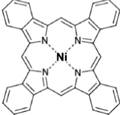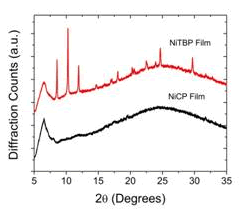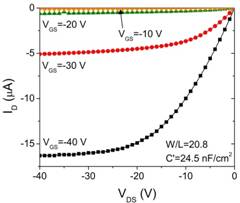
Solution-Processed Polycrystalline Metallo-tetrabenzoporphyrin Organic Thin-Film Transistors
Patrick Shea, Charlene Chen and Jerzy Kanicki
 Metallo-tetrabenzoporphryins (MTBPs) are organic molecules widely studied in biochemistry, and have a well-understood and controllable synthetic process. While TBP itself is insoluble in most organic solvents, the molecule can be synthesized in a precursor form that allows for solution-processing methods such as printing and spin coating. Upon thermal annealing, the amorphous, insulating precursor film converts to a polycrystalline, semiconducting film. We have shown free-base TBP organic field-effect transistors (OFETs) with field-effect mobilities exceeding 0.01 cm2/V-s, while maintaining low sub-threshold slopes (≈1 V/dec), low OFF-state currents (≈10 pA), and moderate threshold voltages (-20 V > VT > 0 V)[1, 2]. While TBP OFET performance is susceptible to ambient exposure, we have demonstrated a novel packaging method to enhance device lifetime[3]. Metallo-tetrabenzoporphryins (MTBPs) are organic molecules widely studied in biochemistry, and have a well-understood and controllable synthetic process. While TBP itself is insoluble in most organic solvents, the molecule can be synthesized in a precursor form that allows for solution-processing methods such as printing and spin coating. Upon thermal annealing, the amorphous, insulating precursor film converts to a polycrystalline, semiconducting film. We have shown free-base TBP organic field-effect transistors (OFETs) with field-effect mobilities exceeding 0.01 cm2/V-s, while maintaining low sub-threshold slopes (≈1 V/dec), low OFF-state currents (≈10 pA), and moderate threshold voltages (-20 V > VT > 0 V)[1, 2]. While TBP OFET performance is susceptible to ambient exposure, we have demonstrated a novel packaging method to enhance device lifetime[3].
 The transfer characteristics of TBP OFETs demonstrate a remarkable degree of linearity compared to other solution-processed OFETs, with field-effect mobility being constant over a wide range of gate voltages (VGS). With its polycrystalline thin-film morphology, this indicates band-like transport. To better understand this aspect of TBP electronic behavior, we are studying the bandstructure of TBP using various quantum mechanical models, and have found a close relation between experimental and computational results. The transfer characteristics of TBP OFETs demonstrate a remarkable degree of linearity compared to other solution-processed OFETs, with field-effect mobility being constant over a wide range of gate voltages (VGS). With its polycrystalline thin-film morphology, this indicates band-like transport. To better understand this aspect of TBP electronic behavior, we are studying the bandstructure of TBP using various quantum mechanical models, and have found a close relation between experimental and computational results.
In collaboration with Prof. H. Yamada and Prof. N. Ono from Ehime University (Japan), we have studied the thin-film morphology and electronic performance of MTBP OFETs. Significant variations in morphology are observed, as well as several orders of magnitude enhancement in electrical performance. We have observed field-effect mobilities as large as 1.1 cm2/V-s and crystals with diameters on the order of 1 mm, all from OFETs using solution-processed films, including devices fabricated on flexible, plastic substrates using organic gate dielectrics.
 Current work is focusing on improved thin-film deposition methods that have produced consistently larger grain diameters, which likely will increase OFET field-effect mobility. Furthermore, we are testing OFETs from liquid nitrogen temperatures to well above room temperature to study the band transport properties; notably, OFET performance is retained to at least 150 degrees Celsius. Finally, we are developing novel device fabrication methods to exploit the aggregation mechanisms common in porphyrins to create highly ordered thin-films, with the goal being to fabricate nano-wire based organic field-effect transistors. Current work is focusing on improved thin-film deposition methods that have produced consistently larger grain diameters, which likely will increase OFET field-effect mobility. Furthermore, we are testing OFETs from liquid nitrogen temperatures to well above room temperature to study the band transport properties; notably, OFET performance is retained to at least 150 degrees Celsius. Finally, we are developing novel device fabrication methods to exploit the aggregation mechanisms common in porphyrins to create highly ordered thin-films, with the goal being to fabricate nano-wire based organic field-effect transistors.
- P. B. Shea, et al., IEEE Transactions on Electron Devices, vol. 52, pp. 1497-1503, 2005.
- P. B. Shea, et al, J. Appl. Phys., vol. 100, 034502,2006.
- P. B. Shea, et al., Synth. Met. (2007), doi:10.1016/j.synthmet.2007.01.013.
top
|

